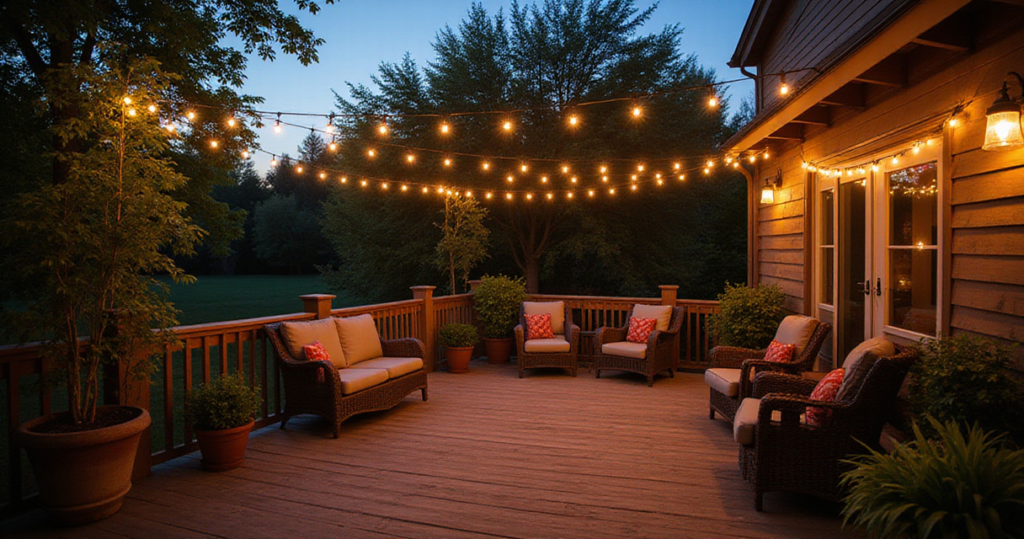Your deck is more than a collection of boards—it’s an untapped canvas awaiting transformation into a personal sanctuary. In our busy lives, having a dedicated outdoor space that combines functionality with mindful design isn’t just pleasant—it’s essential for wellbeing. The following deck ideas decorating approaches draw inspiration from Japanese aesthetics, where simplicity, natural elements, and thoughtful arrangement create spaces that calm the mind and refresh the spirit.
Let’s explore how you can transform your deck into a place that honors both beauty and function, creating an Outdoor Haven that invites you to slow down and appreciate each moment.
1. Illuminate Your Evenings with String Lights
The inspiration for this collection struck when I observed how traditional Japanese paper lanterns transform temple gardens at dusk. String lights create a similar magic, casting a gentle glow that softens the transition between day and night on your deck.
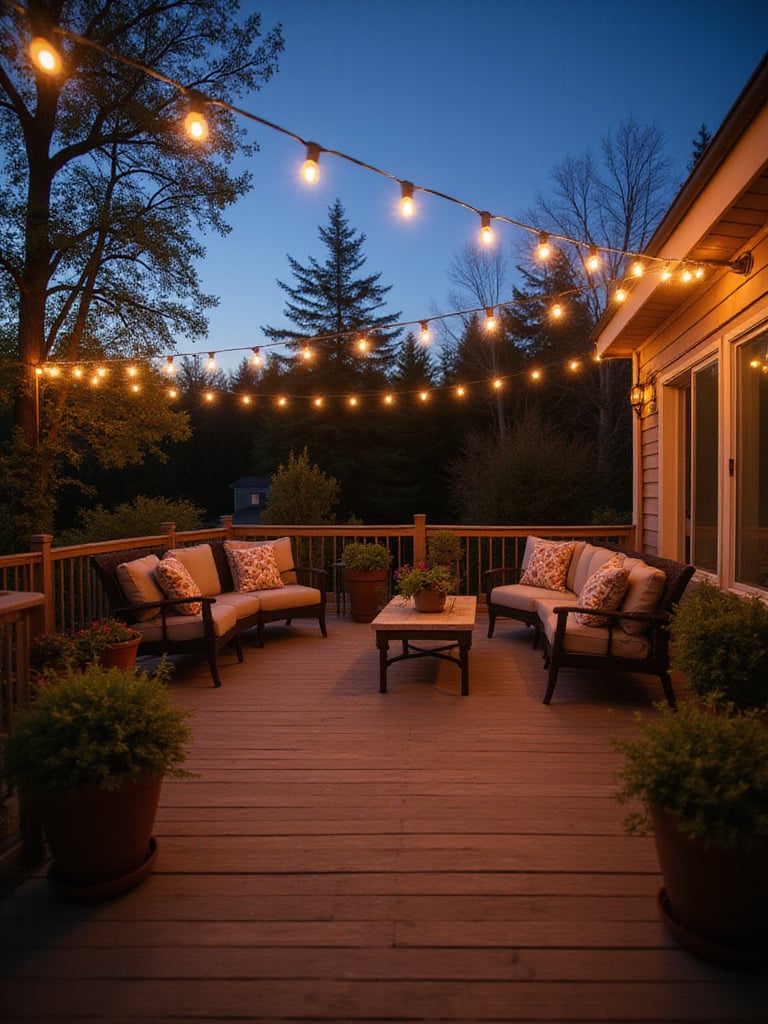
When selecting string lights for your deck decorating project, prioritize durability with IP44 or higher ratings for weather resistance. LED options provide energy efficiency and longevity while producing minimal heat. Choose warm white lights to create the soft, ambient glow reminiscent of traditional washi paper lanterns, rather than harsh cool-toned lighting that disrupts the peaceful atmosphere.
- Create a canopy effect by crisscrossing strands overhead
- Look for solar-powered options to eliminate cord management
- Consider programmable lights that automatically activate at sunset
The interplay between light and shadow creates what Japanese design calls “komorebi”—the dappled light effect that occurs when sunshine filters through leaves. Your string lights can create this same dancing pattern after dark, setting the stage for the foundational elements that will define your deck space.
2. Define Your Space with an Outdoor Rug
What makes this design special is the way an outdoor rug creates ma—the meaningful negative space that defines Japanese aesthetics. Like the carefully raked gravel in a zen garden, a well-chosen rug establishes boundaries and creates visual harmony on your deck.
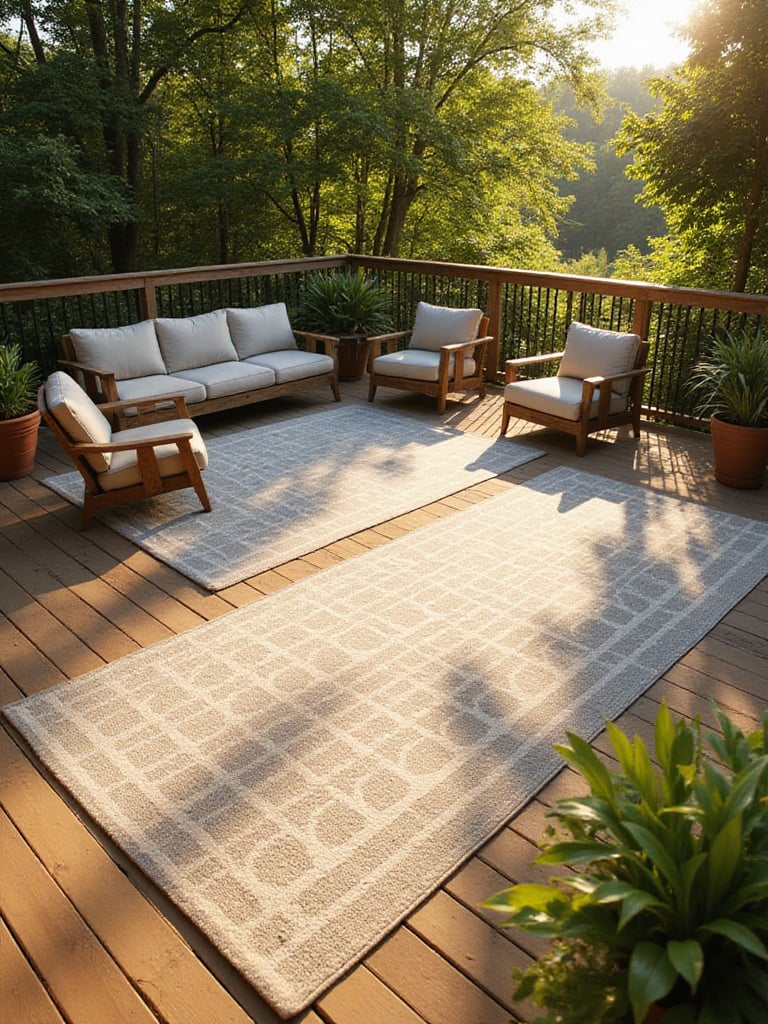
Synthetic materials like polypropylene offer excellent durability for deck ideas decorating projects, resisting fading and moisture while being easy to clean. The pattern you select should complement rather than compete with the natural surroundings—consider subtle geometric designs or textural weaves in earth tones that reference natural elements like stone, water, or bamboo. This grounding element helps define different functional areas while adding warmth underfoot.
“The space between things is as important as the things themselves.” – Traditional Japanese design principle
Running your hand across the texture reveals the thoughtful material selection that makes your deck both beautiful and practical. As you establish this foundation, you’ll find the deck naturally begins to organize itself into distinct zones for relaxation and contemplation.
3. Create a Cozy Nook with Comfortable Seating
The challenge of awkward spaces becomes easier when you approach your deck decorating with the Japanese concept of tokonoma—a special alcove dedicated to contemplation. A cozy seating nook serves this purpose perfectly, creating an intimate space for quiet reflection or conversation.
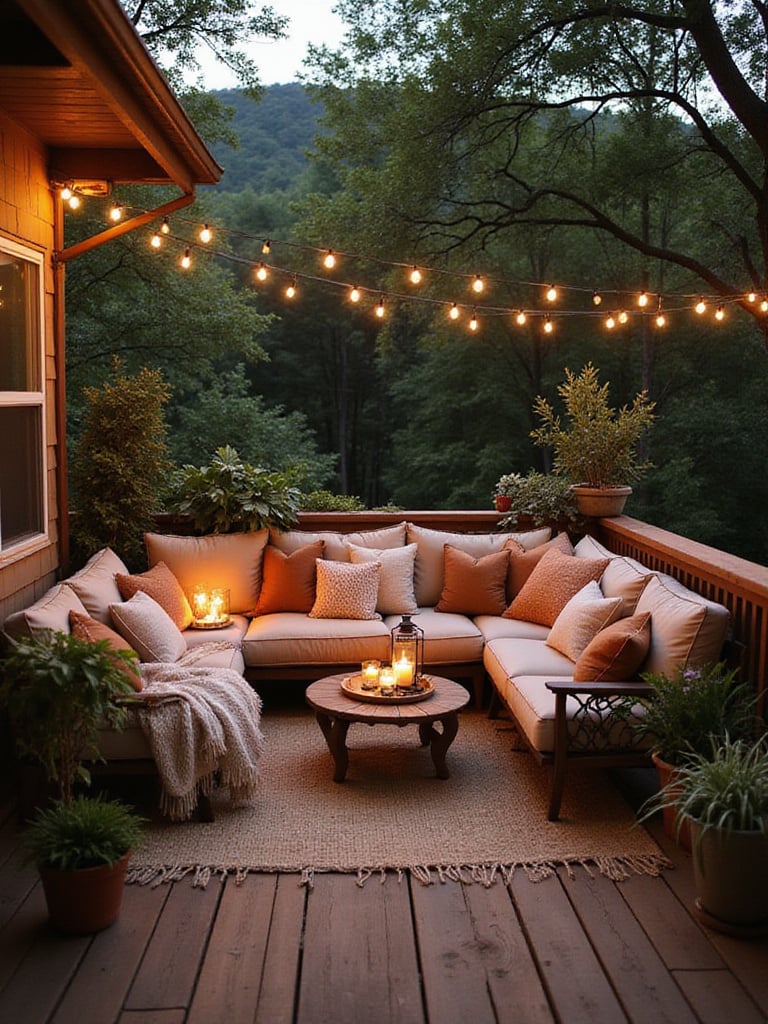
Rather than filling your deck with excessive furniture, consider the minimalist approach of a carefully positioned bench or low seating arrangement. Traditional Japanese furniture sits close to the ground, creating a sense of stability and connection to the earth. Incorporate zabuton-inspired cushions in natural fabrics and subdued colors that can be easily stored during inclement weather. The arrangement should feel intentional but not crowded, allowing for easy movement and the breathing room that characterizes Japanese spatial concepts.
The artisans behind these designs began with the understanding that comfort comes not from excess, but from thoughtful placement and quality materials. This philosophy extends to every element of your deck, including the living components that bring energy and life to the space.
4. Add Pops of Color with Outdoor Pillows and Throws
Beyond aesthetics, the ecological impact matters because textiles connect us to the changing seasons—a concept central to Japanese design philosophy. Outdoor pillows and throws in carefully selected colors can reference seasonal shifts, from spring cherry blossom pinks to autumn maple reds or winter indigo blues.
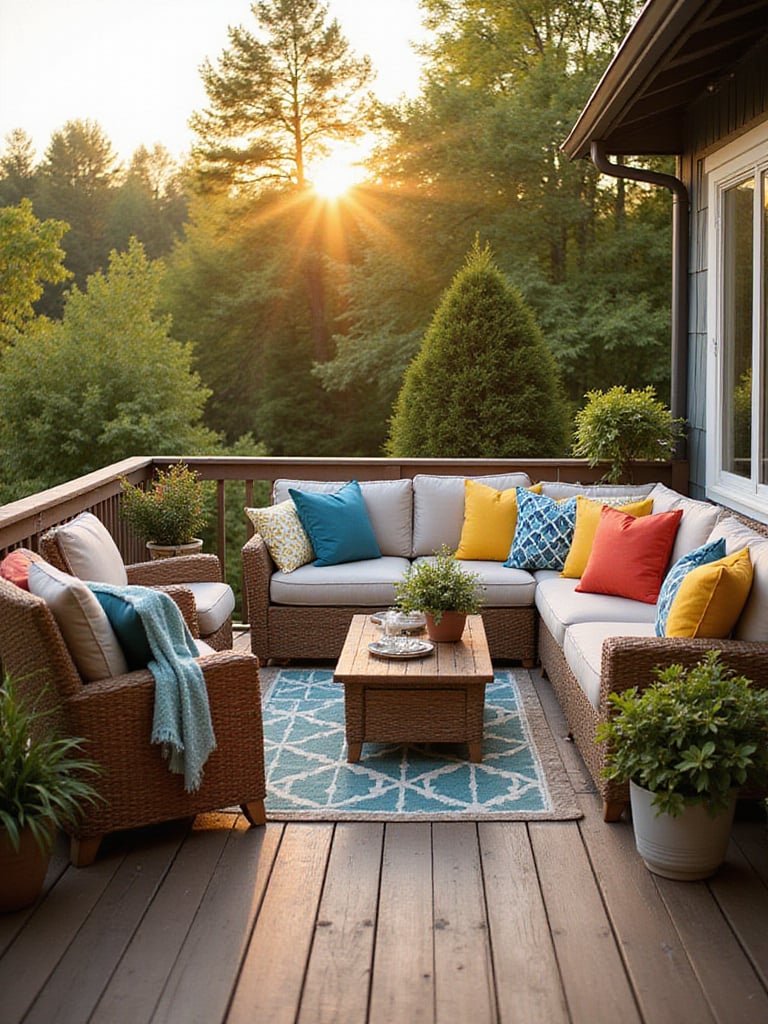
Choose fabrics specifically engineered for exterior use, such as solution-dyed acrylics that resist fading and moisture. Rather than overwhelming patterns, consider subtle textures and tonal variations that create visual interest without disrupting the peaceful atmosphere. Japanese textile traditions like shibori (tie-dye) and kasuri (ikat) offer inspiration for patterns that feel organic rather than manufactured, adding character without chaos.
- Incorporate indigo blues—a traditional Japanese color representing depth and stability
- Choose pillows with subtle geometric patterns inspired by traditional textiles
- Add small accent pillows in seasonal colors that can be rotated throughout the year
The unexpected pairing that always works is combining textural neutrals with one carefully chosen accent color, creating balance without overwhelming the senses. This restraint in color palette allows the natural elements of your deck to truly shine.
5. Bring Nature In with Potted Plants and Greenery
While trendy, this element has staying power because it connects directly to the Japanese principle of shakkei—borrowed scenery that integrates your deck with the larger landscape. Potted plants create this connection, blurring the boundaries between your constructed space and the natural world.
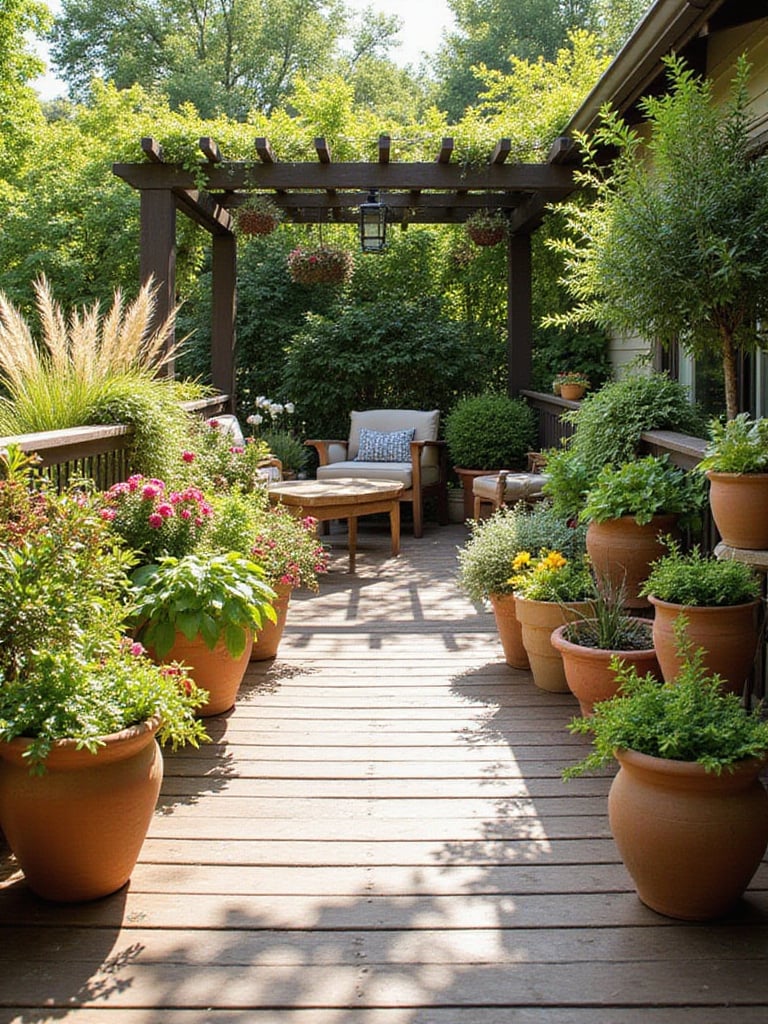
Select plants that offer seasonal interest and require minimal maintenance, mirroring the Japanese garden philosophy of working with nature rather than against it. Consider the sculptural forms of Japanese maples, the vertical lines of bamboo, or the cascading habit of moss. Evergreens provide year-round structure while Flowering Plants like azaleas or camellias offer seasonal moments of beauty. The arrangement should feel natural rather than overly manicured, with varying heights creating a sense of depth that makes even a small deck feel more expansive.
“The garden is a living entity that reveals the passing of time through seasonal changes.” – Japanese gardening principle
The sustainable journey of this material involves choosing plants that thrive in your specific climate and conditions, reducing the need for excessive water or chemical interventions. As your plants establish themselves, they’ll create natural privacy and transition areas that enhance your deck’s functionality.
6. Install a Vertical Garden or Living Wall
The artisan collective that creates these pieces understands that vertical space is just as valuable as horizontal in Japanese design philosophy. A living wall transforms an unused vertical surface into a celebration of nature’s patterns, adding dimension without consuming precious floor space on your deck.
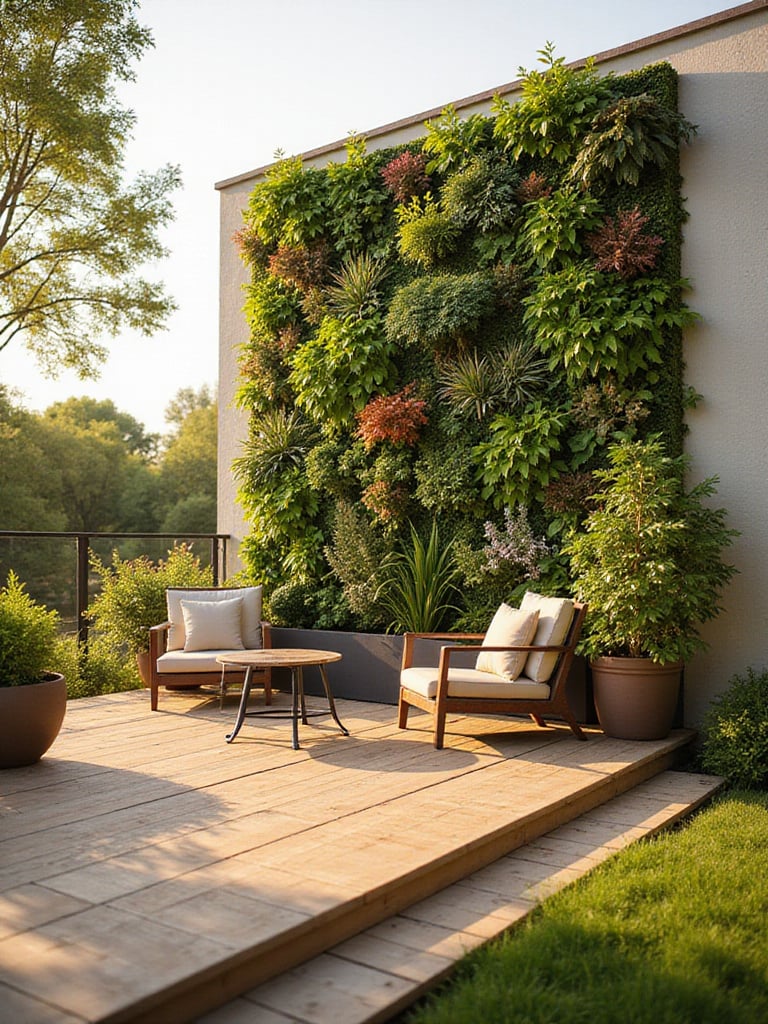
For a Japanese-inspired approach, consider a vertical arrangement of moss, ferns, and small evergreens that references the lush forest floors of Japanese mountain landscapes. Pocket planters or modular panel systems offer flexible options for installation, while a simple bamboo trellis can support climbing plants like jasmine or climbing hydrangea. The composition should feel balanced but not rigid, with plants arranged to create natural-looking groupings rather than strict geometric patterns.
The environmental story behind this piece began with recognizing how vertical gardens can improve air quality and provide natural cooling through evapotranspiration, making your deck more comfortable during warmer months. This functional beauty transitions naturally to another element that enhances both comfort and aesthetics.
7. Enhance Privacy with Outdoor Curtains or Screens
The maker’s journey from apprentice to master influenced my approach to privacy elements, drawing inspiration from traditional Japanese architectural features like shoji screens and noren curtains. These translucent dividers filter light while creating the sense of enclosure that makes a deck feel like a true outdoor room.
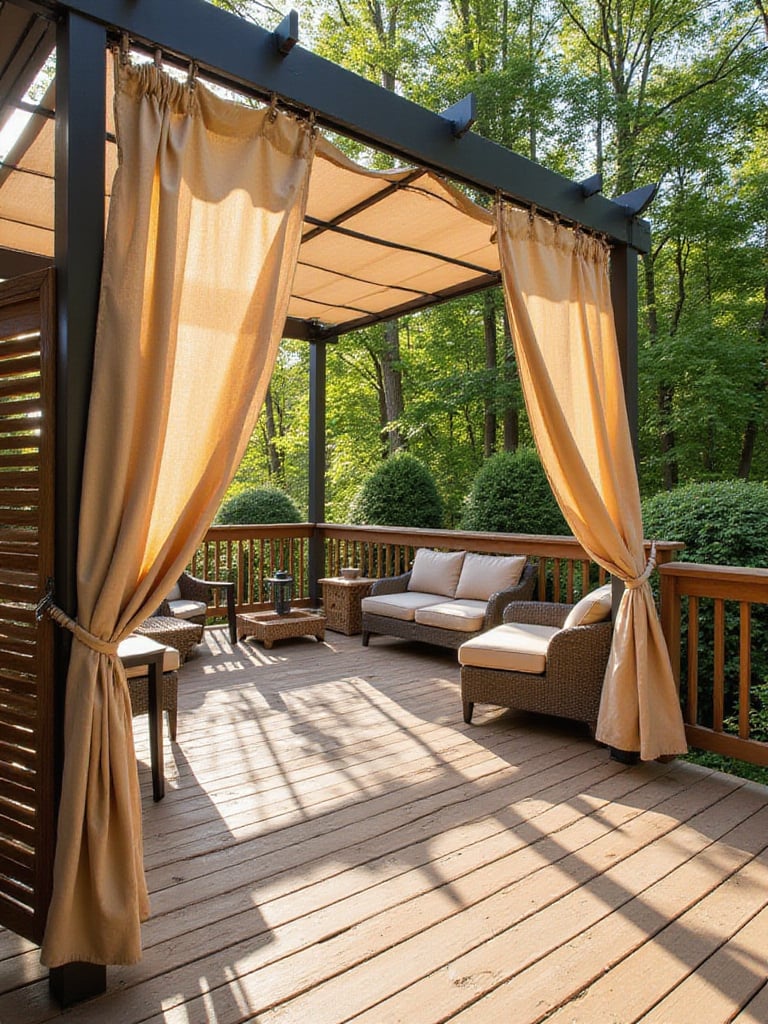
Select materials that move gently in the breeze, creating a dynamic quality that adds life to your deck decorating scheme. Natural fibers like linen or bamboo reference traditional Japanese materials, while modern weather-resistant fabrics offer practicality. The key is finding options that provide privacy without complete separation from nature—the goal is filtering rather than blocking. Consider mounting curtains on sliding tracks that reference traditional fusuma panels, allowing you to adjust the level of enclosure based on weather conditions or desired privacy.
- Install simple bamboo or reed screens for a natural, textural privacy solution
- Use outdoor-rated fabric panels in neutral tones that filter light without blocking it
- Consider retractable options that can be adjusted throughout the day
The evolution of this trend reflects broader cultural shifts toward creating outdoor spaces that function as true extensions of our homes. These privacy elements naturally frame the next important aspect of deck enjoyment: the dining experience.
8. Set Up a Charming Al Fresco Dining Area
If you’ve struggled with similar rooms before, you’ll appreciate how Japanese dining principles transform outdoor meals from casual convenience to mindful ritual. A well-designed al fresco dining area on your deck becomes a place to slow down and fully appreciate both food and company.
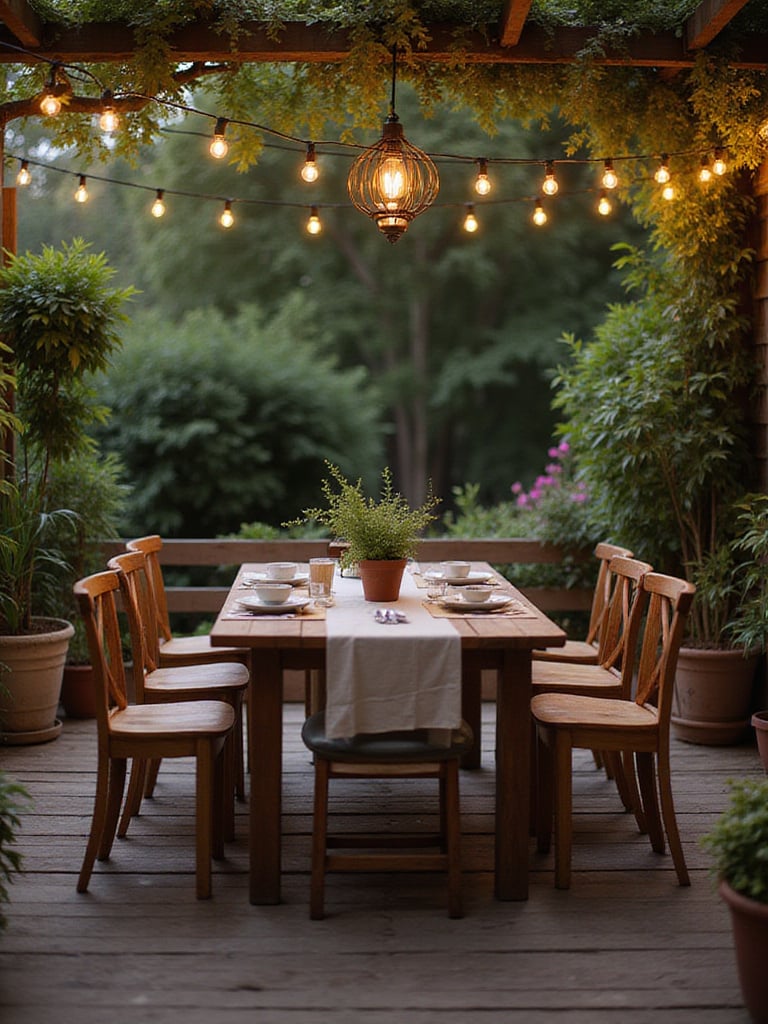
Choose low-profile furniture that encourages a relaxed posture, referencing the traditional Japanese dining experience. A simple wooden table with clean lines and benches rather than individual chairs creates an inclusive, communal feeling. Consider a zabuton-inspired cushion arrangement around a low table for casual meals, creating the intimate atmosphere of a traditional chabudai dining setup. The dining area should feel purposeful but not crowded, with enough space to move comfortably around the table.
The craftsmanship reveals itself in details like the joinery of a wooden table or the hand-finished edges of ceramic serving pieces. These thoughtful elements elevate the dining experience, creating a natural transition to water features that further enhance the sensory experience of your deck.
9. Introduce Serenity with a Small Water Feature
The cultural heritage preserved in each piece includes the Japanese understanding that moving water calms the mind and creates a sense of peaceful transition. A small water feature adds both visual interest and soothing sound to your deck decorating scheme, creating a multi-sensory experience.

Select a water feature that emphasizes simplicity and natural materials, such as a stone tsukubai (water basin) or a bamboo shishi-odoshi (deer scarer). The sound should be gentle rather than dramatic—a soft trickle rather than a splashing fountain. Position the water feature where it can be easily seen and heard from seating areas, creating a focal point that draws the eye and ear. Solar-powered options eliminate the need for electrical connections, making installation simpler and more flexible.
The magic of this piece lies in its ability to engage multiple senses simultaneously, creating a truly immersive experience on your deck. This sensory richness pairs naturally with the primal comfort of fire, our next element for creating a truly inviting outdoor space.
10. Gather Around a Stylish Fire Pit or Table
As morning light filters through, the texture creates a completely different experience than evening gatherings around a fire. The Japanese concept of irori—a traditional hearth that serves as both heat source and cooking area—inspires this modern deck decorating element that extends the usability of your outdoor space into cooler months.
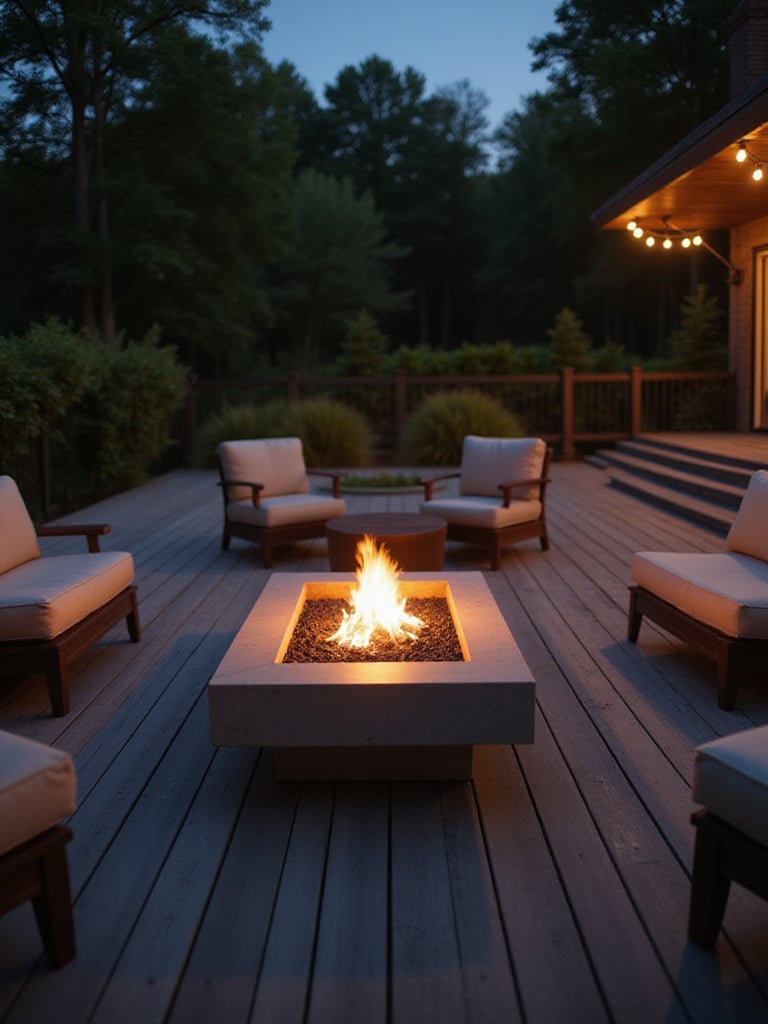
Choose a fire feature with clean lines and natural materials that complement your deck’s aesthetic. A simple cast iron bowl, a ceramic hibachi-inspired design, or a stone fire table all reference traditional Japanese fire elements while providing modern safety and convenience. Position the fire feature where it can be easily enjoyed from seating areas but with adequate clearance from combustible materials and overhead structures. Gas options offer convenience and control, while traditional wood-burning designs provide authentic crackle and aroma.
“Fire connects us to our most ancient human rituals of gathering and storytelling.” – Japanese cultural tradition
Unlike conventional options, this approach reduces the visual complexity that often characterizes outdoor fire features, focusing instead on the elemental quality of flame. This simplicity creates a natural backdrop for displaying meaningful decorative elements that personalize your deck.
11. Hang Outdoor Art or Reflective Mirrors
The designer’s attention to detail shows in the careful selection of wall decor that enhances your deck without overwhelming it. In Japanese design, decorative elements are chosen with intention, each piece having meaning rather than merely filling space.

Consider outdoor-rated mirrors positioned to reflect garden views or water features, creating the illusion of expanded space—a technique used in traditional Japanese gardens to make small areas feel more expansive. For art pieces, weather-resistant metal sculptures with simple lines or abstracted natural forms complement the Japanese aesthetic. Ceramic tiles or plates mounted on walls can reference traditional Japanese pottery traditions while withstanding outdoor conditions. The key is selectivity—choose one or two significant pieces rather than many small ones, allowing each to be fully appreciated.
- Position mirrors to reflect your most attractive plantings or views
- Select art with natural themes like bamboo, cranes, or abstracted landscapes
- Consider metal art that develops a natural patina over time, telling the story of passing seasons
The unexpected environmental benefit comes from the way these reflective surfaces can bounce natural light into shadier areas of your deck, reducing the need for artificial lighting during daylight hours. This thoughtful use of natural resources extends to how you provide refreshments for guests.
12. Create a Refreshment Station with a Bar Cart
The third-generation workshop where this comes to life understands that hospitality is central to Japanese culture, where the ritual of serving drinks becomes an art form. A dedicated refreshment station elevates this experience on your deck, making entertaining both easier and more elegant.

Select a cart with clean lines and natural materials like bamboo or teak that reference Japanese aesthetic principles. Stock it with elements for preparing and serving tea—a nod to the Japanese tea ceremony—alongside more contemporary refreshment options. Include a designated space for a water carafe and glasses, ensuring guests can easily stay hydrated. The cart should be mobile but stable, allowing you to reposition it as needed while maintaining a sense of permanence when in place.
The subtle fragrance fills the room while you prepare drinks for guests, creating an immersive sensory experience that enhances conversation and connection. This attention to detail in hospitality naturally extends to creating the ultimate relaxation spot on your deck.
13. Relax in a Hammock or Hanging Chair
Even in smaller spaces, here’s how this works: a suspended seating element creates a floating quality that references the Japanese concept of ukiyo—the “floating world” that represents detachment from everyday concerns. A hammock or hanging chair becomes a dedicated space for mindfulness and relaxation.

Choose designs with clean lines and natural materials rather than overly ornate options. A simple canvas hammock in natural tones or a hanging chair with minimal framework maintains the serene aesthetic while providing exceptional comfort. Position the hanging seating where it can take advantage of views, breezes, or dappled shade, creating an intentional relaxation zone. The gentle swaying motion has proven calming effects, making this one of the most rewarding additions to your deck decorating plan.
The materials are sourced from a remarkable region where sustainable harvesting practices ensure the longevity of both resources and crafting traditions. This respect for materials and craftsmanship extends to the more permanent elements of your Deck Design, including built-in features.
14. Utilize Built-in Seating for Functionality
Many homeowners wonder how to balance aesthetics with practicality in outdoor spaces. Built-in seating addresses this challenge by incorporating the Japanese design principle of multi-functionality—creating elements that serve both practical and beautiful purposes on your deck.
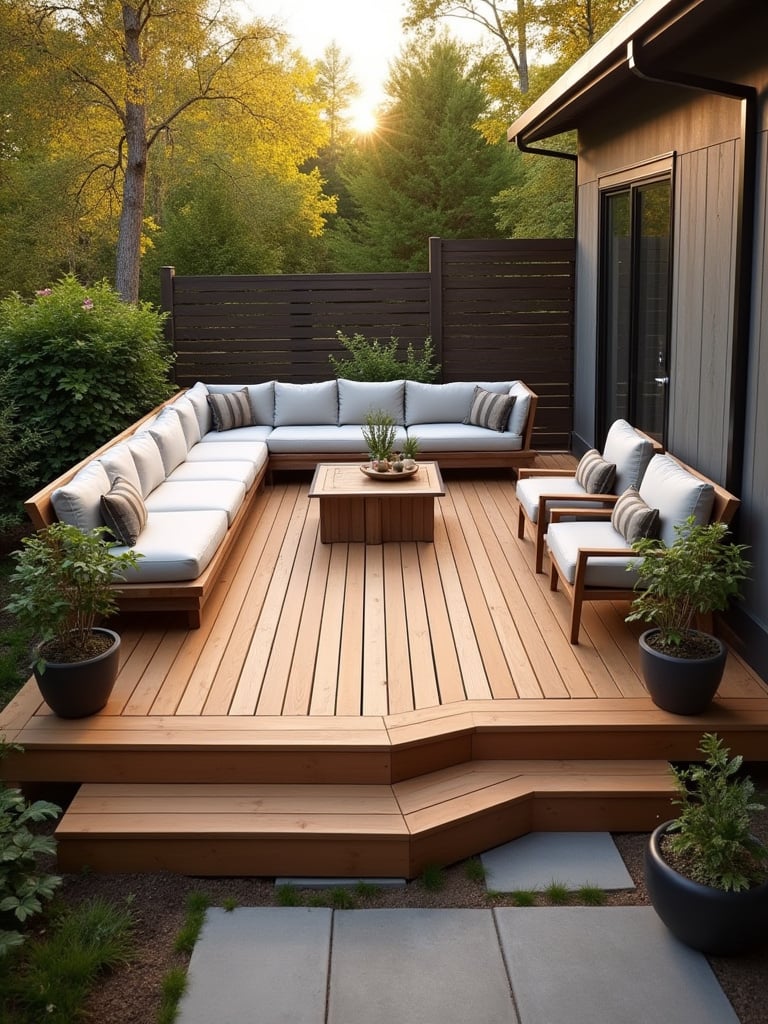
Design built-in benches with clean, horizontal lines that reference traditional Japanese architectural elements. Incorporate hidden storage beneath seat tops for cushions, throws, or outdoor equipment, maintaining the clean aesthetic. The seating should follow the natural lines of your deck, perhaps wrapping around corners or following the edge to maximize space efficiency. Select materials that complement your decking while providing comfortable, durable seating that requires minimal maintenance.
The revival of this classic form comes with a twist of modern materials that offer greater durability and lower maintenance than traditional options. These permanent elements provide structure and definition that can be enhanced with adjustable shade features for changing conditions.
15. Add Shade and Style with a Pergola or Awning
For those worried about maintenance, a pergola or awning offers the perfect balance of architectural interest and practical sun protection for your deck decorating scheme. These structures reference the engawa—the covered veranda that surrounds traditional Japanese homes, creating a transitional space between indoors and outdoors.
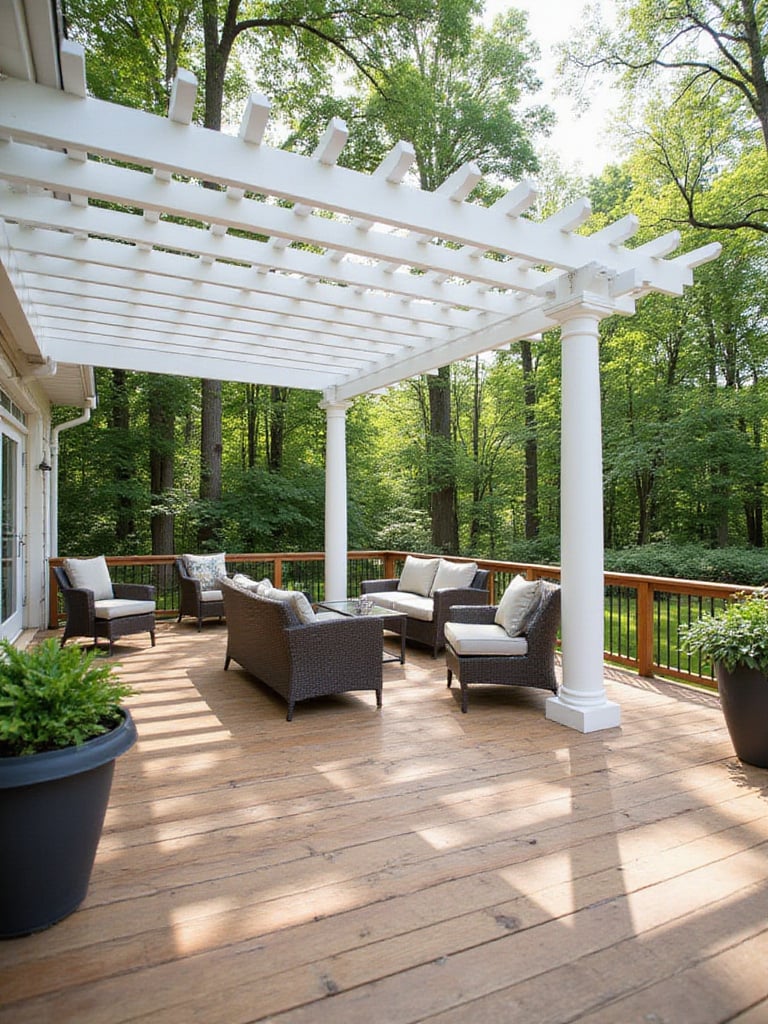
Select a design with clean, horizontal lines and minimal ornamentation, allowing the structure itself to become a sculptural element. Traditional Japanese architecture emphasizes exposed beam work and joinery, which can be referenced in a contemporary pergola design. Consider incorporating sliding panels or retractable fabric that allows you to adjust sun exposure throughout the day, mimicking the flexibility of traditional Japanese architecture. Natural materials like wood create warmth, while metal options offer modern durability with clean lines.
The ambiance evolves throughout the day as natural light filters through the structure, creating changing patterns of light and shadow across your deck. This dance of light creates a dynamic quality that complements the more permanent aspects of your deck surface.
16. Refresh Your Deck Floor with Stain or Paint
The unexpected color story emerging this year draws inspiration from traditional Japanese color palettes—muted earth tones, soft indigos, and the weathered gray of aged wood. Refreshing your deck floor with the right stain or paint creates a foundation that supports the entire design concept.
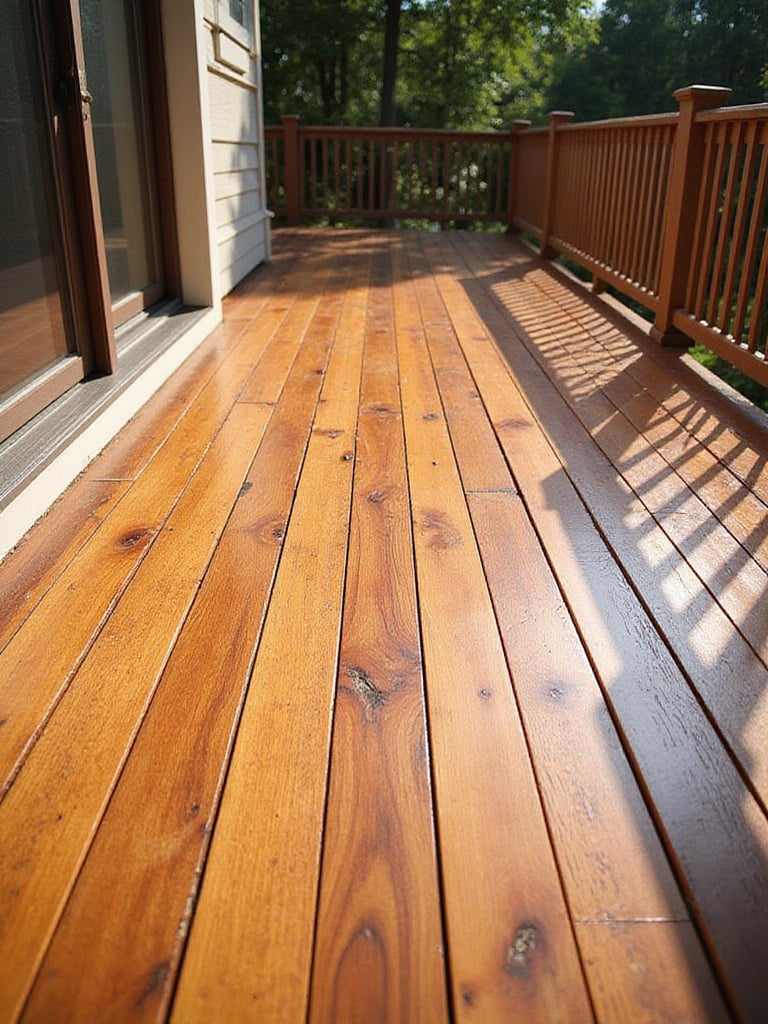
Consider darker stains that reference the charred wood finish of shou sugi ban, a traditional Japanese technique that preserves wood through controlled burning. Alternatively, light, natural finishes that highlight the wood grain create a sense of warmth and connection to nature. The finish should be matte rather than glossy, reflecting the Japanese preference for subtle, understated surfaces that develop character over time. Ensure proper preparation and application to maximize durability and minimize maintenance requirements.
- Choose earth tones like stone gray, moss green, or walnut brown
- Consider the traditional Japanese indigo blue for a subtle accent color
- Apply finishes in thin layers to maintain the natural character of the wood
The traditional methods used result in a surface that feels authentic and grounded, providing the perfect foundation for the other elements of your deck design. This attention to the deck surface naturally leads to considerations about comfort in varying weather conditions.
17. Stay Cool with an Outdoor Fan
When clients ask us about balancing style with comfort, outdoor fans offer an elegant solution that references the Japanese tradition of using natural air circulation to cool spaces. A well-chosen fan enhances both the comfort and aesthetic of your deck decorating scheme.
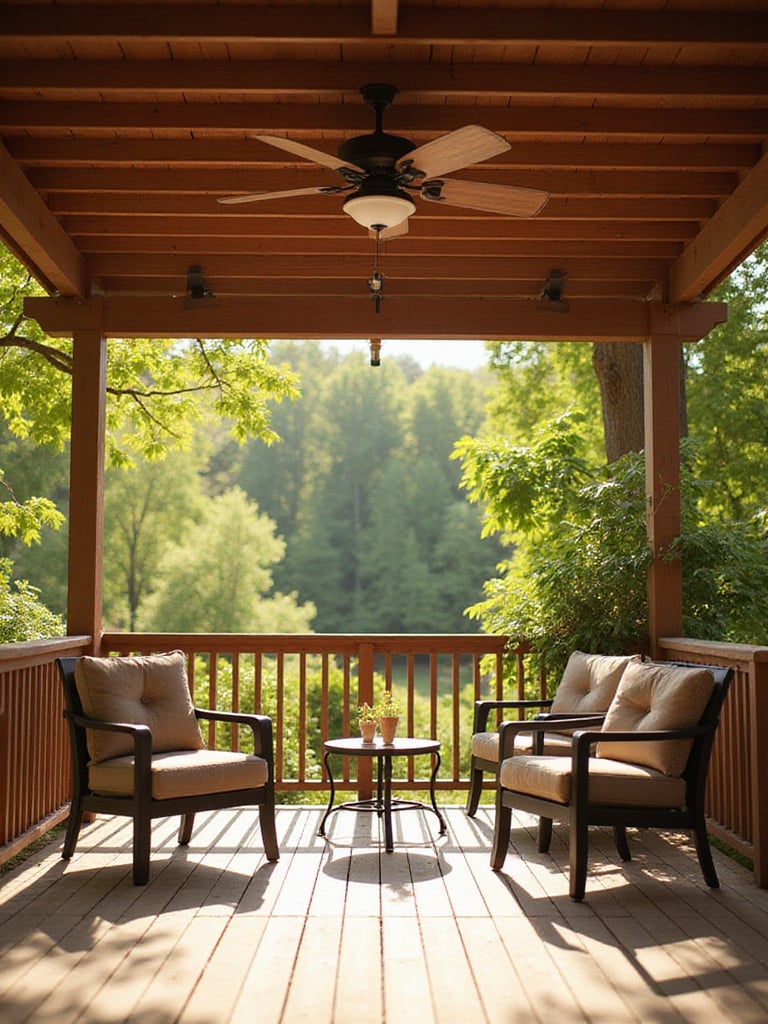
Select fans with simple, clean lines and natural materials like bamboo or wood that complement your overall design. Position them strategically to maximize air circulation without creating direct drafts on seating areas. Look for wet-rated options if your deck is exposed to the elements, ensuring safety and longevity. The fan should feel like an intentional design element rather than an afterthought, with finishes and styles that enhance your overall aesthetic.
The environmental story behind this piece began with ancient Japanese cooling techniques that used natural air movement rather than mechanical cooling, creating comfort while minimizing resource consumption. This thoughtful approach to comfort extends to how you organize the various functional areas of your deck.
18. Design Distinct Zones for Different Activities
Look closely and you’ll notice the subtle texture of transitions between spaces in traditional Japanese design. Creating distinct zones on your deck references the Japanese concept of shakkei—”borrowed scenery”—where each area frames a different view or creates a unique experience.

Divide your deck into functional areas using subtle cues rather than hard boundaries. A meditation corner might feature a small tatami-inspired mat and zafu cushion, while a dining area is defined by a change in decking pattern or a pergola overhead. Use potted plants or partial screens to create gentle transitions between zones, allowing each to feel distinct while maintaining overall flow. Consider the natural movement patterns across your deck, ensuring that pathways between zones feel intuitive and unobstructed.
The styling mistake most people make is forcing too many functions into a single undifferentiated space. By thoughtfully creating zones, you allow each area to fully realize its purpose while making the overall deck feel more spacious and intentional. These zones provide perfect settings for showcasing special plant specimens in carefully chosen containers.
19. Showcase Plants in Unique Decorative Planters
The discovery of this technique happened when studying how Japanese gardeners elevate certain plants to specimen status through careful pot selection and placement. Decorative planters become art objects in themselves, complementing and highlighting the plants they contain.
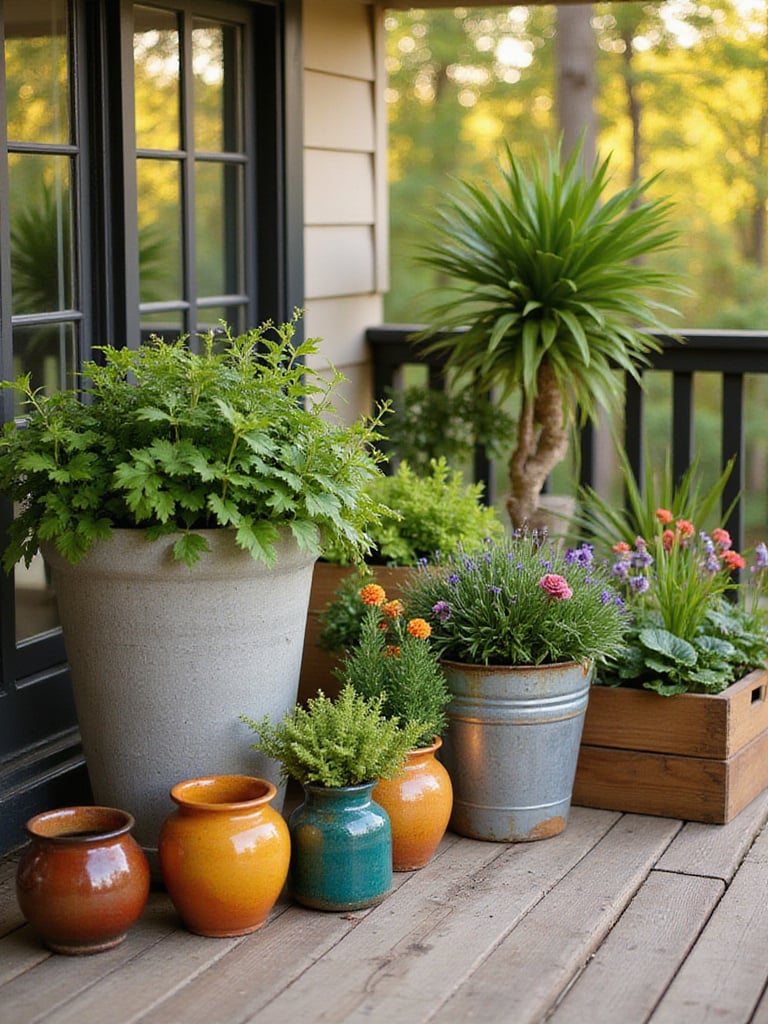
Choose containers with simple forms and natural materials like unglazed ceramic, weathered concrete, or aged copper that develop patina over time. Traditional Japanese plant containers like weathered clay pots or wooden boxes offer authenticity, while modern interpretations in similar materials provide contemporary appeal. The container should complement rather than compete with the plant, creating a harmonious relationship that draws attention to both. Position special specimens where they can be viewed and appreciated from seating areas, creating focal points that reward close observation.
The materials are sourced from a remarkable region where traditional crafting techniques have been preserved for generations, ensuring each planter tells a story beyond its immediate function. This attention to detail and authenticity extends to how you incorporate cooking and dining functions into your deck design.
20. Incorporate a Grill or Outdoor Kitchen Element
The silhouette draws inspiration from the traditional Japanese irori—a sunken hearth that served as both cooking area and gathering place. A modern interpretation through a grill or outdoor kitchen element creates a functional centerpiece for your deck decorating scheme.

Design your cooking area with clean lines and minimal ornamentation, focusing on quality materials and functional excellence rather than elaborate features. Consider incorporating teppanyaki-style flat cooking surfaces alongside traditional grilling options, referencing Japanese cooking traditions. Storage should be discreet and integrated, maintaining the clean aesthetic while providing practical functionality. Position the cooking area where smoke won’t interfere with relaxation zones but close enough to dining areas for convenience.
The finishing touch that elevates the entire look is the careful integration of natural materials like stone countertops or wood accents that complement your overall deck design. These thoughtful details create a cooking space that feels both functional and aesthetically aligned with Japanese design principles.
Conclusion
Your deck holds potential far beyond its structural purpose—it can become a sanctuary that honors the Japanese principles of simplicity, natural beauty, and mindful design. By implementing these deck ideas decorating concepts, you’re creating more than just an attractive outdoor space; you’re crafting an experience that encourages presence and appreciation of each moment.
The beauty of Japanese-inspired design lies in its timelessness. Unlike trendy approaches that quickly feel dated, these principles have guided aesthetic decisions for centuries because they speak to something fundamental in human experience—our need for spaces that feel both beautiful and meaningful. Your deck can become such a place: a personal retreat where nature and design harmonize, creating moments of tranquility in our often chaotic world.
